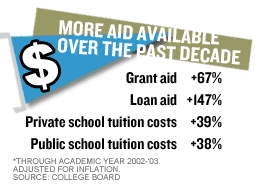NEW YORK (CNN/Money) – College costs once again have increased far faster than inflation, with tuition at state schools posting the biggest increase in 30 years, the College Board reported Tuesday.
| 
| |

| 
| 
|

|
 College tuition costs are up, but so is the financial aid. CNNfn's Mary Snow takes a closer look at the college tuition study. College tuition costs are up, but so is the financial aid. CNNfn's Mary Snow takes a closer look at the college tuition study.
|
 Play video
Play video
(Real or Windows Media)
|
| 
|

|
|
One bright spot: an increase in the amount of aid students are receiving. Less bright: A significant portion of that aid is in the form of loans.
Students at state schools got hit hardest by the price hikes. The cost of a year at a four-year public university – including tuition, fees, room and board -- rose 9.8 percent to $10,636 from $9,689 last year, according to a report by the board, a nonprofit association that runs college programs and services, including the SATs.
That's an especially big jump considering that inflation, as measured by the consumer price index, has been just above 2 percent for the past six months.

Add in other expenses, such as books and transportation, and the total nut for a year at a state school comes to $13,833, up from $12,841 last year.
Tuition alone at state schools rose 13 percent adjusted for inflation, the highest increase in 30 years, the report said.
Increases were more modest but costs remain far higher for private colleges. Costs rose 5.7 percent to $26,854. Include books and other items and the total comes to $29,541, up 6.7 percent.
The biggest cause for the increases at state schools: State appropriations have not kept up with rising costs. State funding typically accounts for more than a third of public schools' funding, according to the board.
In addition to a relative decline in state appropriations at public schools, there are other reasons costs at all schools have been rising. Faculty compensation is up, primarily because of health-insurance and pension costs. Universities also have spent heavily to keep technologies current both for research and teaching purposes.
Most of all, grant aid is climbing.
"Financial aid is the fastest-growing component of institutional budgets," said Sandy Baum, a consultant to the College Board and one of the authors of its report.
On the bright side, more aid
Indeed, as costs have grown, so has the amount of financial aid students have received when federal, state and institutional funds are combined, according to the College Board. So has the number of students receiving that aid, which can come in the form of loans, grants, work study and tax credits.

Last year – the latest for which aid data are available -- about 60 percent of undergraduates received some form of aid, according to a second College Board report, Trends in Student Aid.
Of those, nearly half received grant money which, unlike a loan, doesn't need to be repaid and effectively reduces the price paid for college.
On an inflation-adjusted basis, from the 1992-93 academic year through the end of the 2002-03 school year, grant aid per full-time student rose 67 percent and loan aid rose 147 percent. Tuition during the same period, meanwhile, rose 39 percent at private colleges and 38 percent at public universities.
| COLLEGE CALCULATORS
|

|
|
|
|
Total aid to an eligible full-time student averaged $9,100 last year, with $3,600 of that in grants.
Grant aid per full-time student rose 9 percent. For aid-eligible students at four-year public schools, the average student received $2,400 in grants. A student at a four-year private school received an average of $7,300.
Still, signs of stress
While total aid has increased, the share of grants as a percentage of total aid has declined. In 1982, grants made up more than 50 percent of all aid. Last year, they constituted just 40 percent.
The neediest students are getting a smaller piece of the grant pie, too. According to Baum, less of the new grant money is earmarked for need-based recipients and more is set aside for merit-based awards – which tend to go disproportionately to middle- and upper-income students.
Since loans make up a large portion of many students' financial aid packages and those aid packages have grown, so has the debt burden students carry into their adult lives upon graduation. Since 1997, the median in undergraduate student loan debt has risen 74 percent to $16,500, according to Nellie Mae's 2002 National Student Loan Survey.
And there are signs more of the burden may be borne by students as their parents struggle to save.
Some parents of young children who are trying to ward off tuition hikes in the years to come have opted to contribute to pre-paid tuition plans, which allow you to buy tuition credits at today's prices and bank them for the day years hence when your child goes to college.
But some of these plans are experiencing the strains of college costs. Several states recently suspended enrollment in their pre-paid tuition plans since the cost of tuition is rising faster than the plans' investment earnings.
And parents' savings, at least judging from a recent survey by the Investment Company Institute, can't keep up with the rising costs. The ICI found that of all parents saving for college, those with children between the ages of 11 and 15 had saved a median of only $15,000.

|

